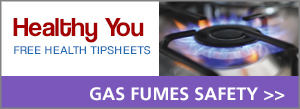When sensors first detected the rumblings of the March 11 earthquake that devastated much of Japan, they transmitted the information around the world in seconds.
One of the places the data were sent was the Pacific Disaster Center in Hawaii, where news of the quake and the potential for a tsunami were relayed through the center’s Twitter feed and a smartphone app. The information was relayed before CNN began reporting on the quake, said Ray Shirkhodai, executive director of the center.
As technology has advanced, so too have the ways that public health officials are communicating with the public. Twitter, Facebook and smartphone apps have become the latest tools in the public health and disaster preparedness fields, in part because they allow officials to reach a large number of people quickly with important information.

A man looks over the devastation in Japan on March 16. Warnings and details about the earthquake, tsunami and ensuing radiological emergency were tweeted and texted as they occurred.
Photo by Nicholas Kamm, courtesy AFP/Getty Images
Before Twitter and Facebook, the Pacific Disaster Center used online messages sent to subscribers. In Arlington County, Va., officials began warning residents years ago about disasters with road signs warning of water main breaks and an AM-band radio station. They moved on to email and their website, but still, said Diana Sun, communications director and assistant county manager, it felt like there was a missing piece.
“We’re sitting here in the nation’s capital, a top national media market,” she said. News channels would cover large events like a hurricane, but not a water main break that would disrupt the morning commute or require residents to boil their water.
Now the county uses text messaging and email to send alerts to people who sign up for the free service known as Arlington Alert — with more than 25,000 subscribers at most recent count.
“The thing is to try to bring your information where the people are,” she said.
Posting information on Web pages people are already using increases the likelihood that people will see those messages.
The Boston Public Health Commission also uses social media to reach out to its users. It has 4,500 followers on Twitter and thousands have signed up to follow the commission’s various Facebook pages.
“We figured out that we needed to reach them where they are,” said Ann Scales, director of communications for the commission. “The people who see what we’re saying are not just the folks who follow us, but the followers of our followers of our followers.”
The commission used social media to get the word out about vaccine clinics during the H1N1 outbreak, for example.
“During the outbreak, we used Twitter quite a bit to push out information on our flu clinics,” Scales said.
The commission tweeted not just the location of clinics, but news that there was no wait for vaccines, which was meant to encourage people to get vaccinated. She said the commission has not yet needed to use the social media tools in any kind of mass casualty event, but it could if necessary.
The Boston Public Health Commission hired a social media director and bought some new software so it could produce videos for YouTube, but Scales said such expenses are not always necessary. Facebook and Twitter accounts are free, and responsibility for posting to pages can be shared among multiple employees.
The commission tweets via @HealthyBoston, posting messages every few days about events such as violence interventions and the Office of Oral Health’s spring event.
“What goes out has to be factually accurate,” Scales said. “We don’t just fill up people’s screens with useless information. We are selective in the type of information we put out there.”
In a typical week, Sun said, Arlington Alert might send one message, but the county tries to limit text messages, both because some users have to pay for them and because they want the messages to be taken seriously.
Despite their popularity, social media tools are not being used by health officials to replace more traditional methods of communication, such as websites, television and newspapers.
One of the problems with social media is authentication, said John Van Thaden, general manager for alerting and notification for Federal Signal Safety and Security Group. His company provides systems to groups that need to keep large numbers of people informed in the event of an emergency. The company started with outdoor warning signals as part of the U.S. civil defense systems. Today, it works with emergency managers, military bases, hospitals and college campuses on notification systems that include telephone, television and, increasingly, social media.

Volunteers clean up sandbags used to prevent flooding in St. Clair, Minn., in 2010. Officials are using social media and texting to organize volunteer efforts during and after disasters.
Photo by Patsy Lynch, courtesy FEMA
“The biggest thing that we see is that we are such a diverse population with a broad range of preferences,” he said.
A survey conducted by the company found that in the event of an emergency, most people turn to television for information.
Still, social media is another tool in the arsenal of the public health and disaster preparedness and response community. It works in concert with more traditional methods to reach the widest range of people possible.
Nowhere was that more evident than in the aftermath of the recent earthquakes in New Zealand and Japan. Google created a Person-Finder page where people could go if they were looking for someone or if they had information on someone. The Japan page includes more than 530,000 records.
The American Red Cross also collected donations from people from around the United States for victims of the Japanese earthquake via text messages, and people were able to follow the unfolding of the earthquake and tsunami in real time using Twitter hashtags #prayforjapan, #japanquake, #tsunami and #japan, according to the American Red Cross.
In times of disaster, a well-organized social media program can prove vitally important, said Richard Serino, deputy administrator of the Federal Emergency Management Agency.
An earthquake or tornado might cause a power outage. People without battery-operated radios can be cut off from the news, and social media tools and text messages might be the only way to communicate.
“In 140 characters, we can tell people to go to high ground” or to stay away from an unsafe area, Serino said. “One person on a cell phone on a beach can tell hundreds of people around them that a tsunami is coming.”
FEMA uses social media for communication not just from the agency to the public, but the other way around as well. People have sent tweets to FEMA about roads that have washed out in a storm, or posted YouTube videos about dangerous situations. The agency cannot respond to every post, Serino told The Nation’s Health, but it is a way to make communities aware of what is happening around them.
For more information on FEMA’s social media tools, visit www.fema.gov/help/social_media.shtm.
For information on how you can help the victims of the Japan disaster, visit www.apha.org/programs/globalhealth/issues.
- Copyright The Nation’s Health, American Public Health Association









